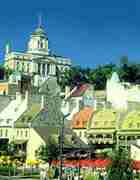French Canadian Treasure — Old Quebec
| We wound our way through Old Town Quebec’s narrow, cobbled, Latin Quarter streets, searching for #32 rue Charlevoix. Seventeenth and 18th century Mansard roofs lined the alleys and gave a European flavor to North America’s only walled city. Rounding a bend at the back of Hotel-Dieu Hospital, our search was successful. The door, marked inconspicuously in French, "Sonnez s’il vous plait...Musée des Augustines," instructed us to ring the doorbell. Peaking from behind the open-cracked door, a bespectacled nun smiled, then laughed heartily at my broken-French request to view the museum. Motioning us to follow, she led us down a flight of steps through a sterile hospital corridor. Leaving us in a low-ceilinged, single-room museum, we found ourselves alone with an attendant nun who nodded, then resumed her reading. |  |
Augustine nuns arrived from Dieppe, France in 1639 and established the Hotel-Dieu Hospital of Quebec. Musée des Augustines, attached to this structure, is filled with an historic gold mine of those days. We gleaned the history in examining artwork, clothing, furniture, and religious artifact exhibits. The medical instrument collection peaked our interest with its blood-letting lancets, primitive microscopes, and pill-making machines.
The highlight of our visit was a tour of the attached hospital’s cellars. The on-duty nun proudly escorted us and recounted in lilting English how Augustine nuns and Quebec villagers hid here from British bombardments in the 1600s. The darkness and dampness of the cellars chilled us -- a reminder of what the French settlers must have experienced. British cannon balls that had penetrated the hospital walls still lay scattered on the cellar floor.
Lively Sights and Sounds
 |
Discovering Musée des Augustines increased our appreciation of Quebec’s varied history. As we left the museum we wanted to enjoy Quebec’s present-day ambiance. The Latin Quarter, named for the language spoken by its students in the 1800s, provided many cafe and bistro choices along rue St.-Jean. It was thronged with today’s student population. Which cafe to choose? We decided on a terrace cafe which served frothy cafe au laits in large steaming bowls. From there we headed northeast to the city walls along rue des Ramparts which takes in the majestic St. Lawrence River toward Ile d’Orleans. The original cannon emplacements still overlook the busy river. Finding a gate to the lower town, we descended steeply to flowered rue St.-Paul and its colorful galleries where street vendors and window shoppers mixed amiably. |
| Quebec’s History Lives Turning southwest we headed to Place Royale, the heart and soul of the original settlement. In 1608 Samuel de Champlain sited his residence and early Quebec around this cobbled square bordered by buildings with steep Normandy-style roofs. On the northwest corner of the square we entered the cool musty cellars of Maison des Vins which sells vintage wines, continuing its tradition as a wine warehouse since 1689. The quaint restored church, Notre-Dame-des-Victoires, built in 1688, sits on the site of Champlain’s original home at the square’s southwest corner. |
 |
We headed south from the square to rue du Petit-Champlain, Quebec’s oldest street and North America’s oldest commercial thoroughfare. The restored shops, galleries, cafes, and restaurants which retain the size and feel of early Quebec beckon for exploration. We found a terrace cafe bordering a flowered park and street, then we settled down to enjoy its color and liveliness. With the cliff to upper Quebec looming behind us us, we sipped our espressos and reviewed our guidebook.
 |
Ascending the stairway, Escalier Casse-cou (Breakneck Stairs), we retraced the steps of French settlers accessing the lower and upper towns. Catching our breath at the top we turned and viewed Quebec’s most famous landmark, Hotel Chateau Frontenac, where we had started our tour. On its cliff-side site, the Chateau is visible for miles from the river and surrounding communities. Originally a colonial governor’s mansion, today’s large hotel was built in 1897. A walk-through of the lobby rewarded us with an appreciation of its rich elegance. Just outside the luxury hotel, Terrasse Dufferin stretches as a boardwalk along the upper edge of the cliff, providing excellent views across the river. It was a fitting place to complete our day-long walking tour of Old Quebec. |
Enthralling Night Life Too
| That evening we discovered another face of Quebec. Just outside the old city walls, rue St.-Louis becomes Grande Allée Est and is lined with three blocks of restaurants, clubs, pubs, and cafes. The whole street seems to jump with action. We had a hard time making a restaurant choice before deciding on Normandy cuisine of crêpes and specialties which rewarded our palates. But we weren’t satisfied with just a single stop. We couldn’t resist a street terrace pub which served excellent beer in two-foot long-necked glasses. The clientele was friendly and a group of locals at the neighboring table struck up a conversation with us Americans (gladly in English). They even demonstrated how to quaff an entire long-stemmed beer in one raising, a feat which we could not duplicate. Later that evening we walked back into the Old Town and enjoyed a rousing jazz set at Hotel Clarendon on rue St.-Anne. By the time we returned to our small hotel near Chateau Frontenac we knew we would soon revisit Quebec for further discoveries. |  |
Click here for details to plan your own trip to Canada’s treasured city of Quebec.
Les Furnanz